How Super Smash Bros. Melee Has Stood The Test Of Time
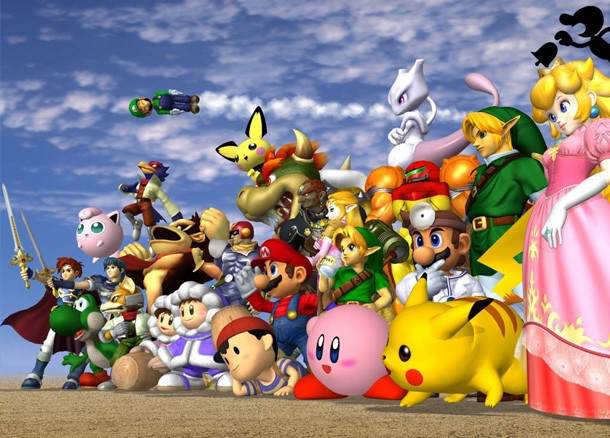
No other game in the fighting-game community has managed to stay relevant for as long as Super Smash Bros. Melee. With a 16-year lifespan and a community that puts it above all else, Super Smash Bros. Melee continues to evolve without ever receiving a single patch. A closer look at the community reveals what sets it apart from other fighting games. The incredible depth of Melee, combined with the undying love of a dedicated fanbase has forged the game into a powerhouse that continues to thrive while other games dwindle and die.
“The Greatest Game Ever Created”
Christopher “Wife” Fabiszak, is veteran Melee player and commentator who understands Melee’s complexities. When he calls Melee “the greatest game ever created,” he’s not just talking about how fun it is in comparison to other games, but how deep the gameplay goes.
“Smash is a sandbox fighter,” says Fabiszak. “The nearly infinite range of movement allows for creativity and expression like no other game.”
Paired with a vast roster of characters, Smash’s innovative movement allows for players to create their own playstyle. The ability to move in any direction, aided by complex stage designs and a myriad of defensive and offensive options, makes Smash an interpretive game. One player might use a character’s speed to rush in and pressure their opponent with combos, while another might use that same element of a character to do short bursts of damage and flee.
What really sets Melee apart from other fighting games, however, is an emphasis on movement under fire. While other fighting games are limited in their defensive options while players are under attack, Smash’s unique movement options allow players to escape situations easier. Intricate techniques like 'L-Canceling' aerial actions , where players hit a button to recover out of a landing animation, are commonplace in competitive melee. Techniques like this can change the entire flow of a match, and take place in literal seconds.
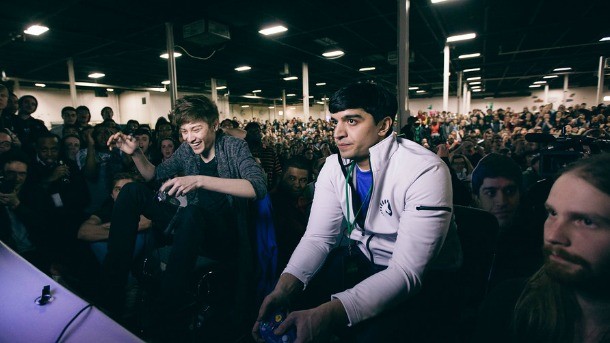
Khan faces off with rival William "Leffen" Hjelte in a money match at Apex 2015.
Kashan “Chillin” Khan is a professional Melee player currently playing for Team Liquid, who believes the skill ceiling for the game is “so high that no human will truly reach it”. It’s not uncommon in fighting games for players to spend hundreds of hours practicing on a single character, but in most fighting games each character has a specific playstyle. Zangief from Street Fighter for instance, isn’t going to be played as a fast, combo-heavy rushdown character when his slower, grab-heavy moveset clearly dictates him a grappler. On the other hand, Smash’s characters don’t fall into predetermined roles. How they’re played can differ completely from player to player, creating a higher skill ceiling that is based on more than just an understanding of character movesets and matchups. “There are so many precise techniques that take hundreds if not thousands of hours to master,” says Khan “and people are only just beginning to get the hang of them.”
In games like Street Fighter or Mortal Kombat, players have to wait until an opponent is finished with a combo to retaliate, or utilize a combo breaker. In Melee, the player can influence their characters movement mid-combo, allowing them to escape or get a better handle on the situation. “That’s always been one of the beauties of Smash to me,” says Khan. “The fact that you just got opened up doesn’t mean you have to wait until your opponent messes up to...retaliate.”
Melee’s deceptively simple gameplay also lent itself well to casual play, and its iconic characters only broadened its appeal. Nintendo had accidentally created one of the deepest fighting games ever, but that didn’t change that Melee was designed as a game for everyone.
“Melee is fun if you’re seven, it’s fun if you’re high in a dorm room, it’s fun if you’re dedicating your life to it,” says Fabiszak. “It works on all the levels, you know? To me, there’s never a bad time for Smash.”
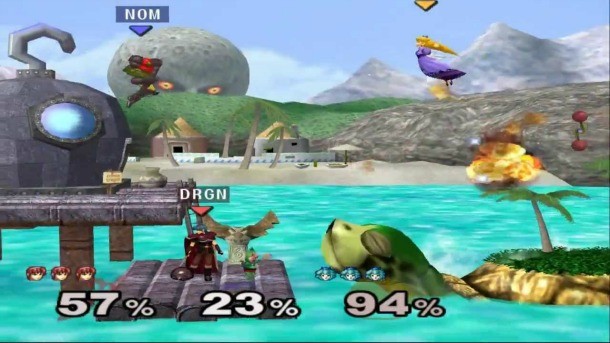
The End of an Era
Shortly after its release, fans recognized the gameplay possibilities in Melee, and a diehard competitive scene began to develop. Both Fabiszak and Khan were there when Melee hit in 2001, though they took different paths through the fandom. Khan knew from the outset that he and his friends were going to take Melee seriously, kickstarting the local competitive scene in his area and hosting tournaments by 2002. Fabiszak found out about these same Melee tournaments through the website Smashboards.com, and decided to go to a tournament with a few friends for fun. After seeing the level of skill on display at these tournaments, he became addicted to getting better, improving his skills, and attending more. “I started going to more and more tournaments, and then it escalates,” says Fabiszak, “because it's a community and then it’s an identity, and before you know it it’s one of the most defining things in your life.”
Although growth was slow, the community in the early days of Melee was rabid for competition, traveling across states to meet up for tournaments, hauling CRT TVs everywhere they went. Rivalries would develop, and turn into storylines that spread between tournaments. The player base was tight-knit, and everyone knew everyone else, or at least had heard of them. It was a community that had one thing in common: they put the game above all else.
“Melee for many, many people is the most important thing in their life,” says Fabiszak. “I would say including me. That means, not people, not a person in your life, but thing in your life.”
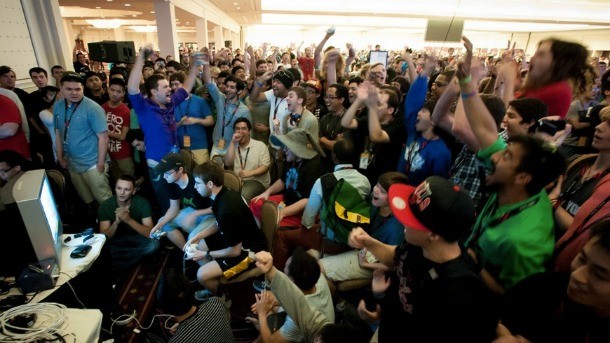
After a few years, Melee had grown to the point of sponsorship, with MLG hosting tournaments alongside Halo. Despite this kind of coverage, the Melee community remained small, and was eventually dropped by MLG after various logistics issues.
“MLG had us alongside Halo, and dropped us partly because Nintendo wouldn’t support them, but also partly because we couldn’t meet our event cap,” says Fabiszak. “Halo would blow up, and we were just the little grassroots community that could.”
After seven years on the market, most communities are ready to move on to a sequel. Melee was no different when Super Smash Bros. Brawl hit shelves in 2008. However, Melee fans soon discovered that Brawl was not the game they had been anticipating. Random, uncontrollable elements added to the game, as well as slower movement, were seen by the community as fail safes on Nintendo’s part to make the game purposefully uncompetitive. Brawl lacked high-level techniques like L-Canceling, and fans were livid at the inclusion of a new tripping mechanic that could randomly leave players in a vulnerable state during dashes.
“It was like an insult, a slap in the face,” says Fabiszak. “And even if you can get over that, just the hype for Brawl, when the bubble burst, that was it. I thought there was no coming back for sure.” With a community lacking proper support and a disappointing sequel fracturing the player base, it seemed like competitive Melee’s best days were behind it.

A New Beginning
For a while the scene dwindled. In 2013, Travis Beauchamp released a nine-part documentary series chronicling the careers of several prominent Melee players, simply titled “The Smash Brothers.” The series was an instant hit inside and outside the community, and generated renewed interest in Melee. Following the lives of several prominent Melee players, including Jason “Mew2King” Zimmerman and Joel “Isai” Alvarado, it revealed a more human side to competitive Melee than had ever been seen before. By showing the friendships, rivalries, defeats, and triumphs, it invested viewers in the personalities and interactions in the scene, giving context that anyone could watch and enjoy.
“It tugged the right heartstrings, told the right stories, and it blew up,” says Fabiszak.
After renewed interest in the scene, Melee returned to EVO 2013, played on the main stage for the first time since 2007. By EVO 2015, Super Smash Bros. Melee had made a huge resurgence, headlining the tournament alongside titles like Mortal Kombat X and Killer Instinct.
“It is impossible to overstate the impact that documentary had on the scene and therefore the lives of anyone still playing,” says Fabiszak. “That was the revival right there.”
The documentary brought with it an influx of new blood to the scene. Some people came to learn the game and compete, while others were content to watch the game they had just learned so much about. Melee was in the midst of a resurgence, the likes of which is practically unheard of in fighting games.
After the disappointment of Brawl, Melee fans were much more accepting of Super Smash Bros. for Wii U when it came out in 2014. Ready to accept the game for what it was, Smash fans found that Nintendo’s newest entry was a much more competitively viable game than Brawl, and a kindred community emerged for Super Smash Bros. (2014). Yet unlike many other fighting games, when the next iteration came out, Melee didn’t die; it coexisted.
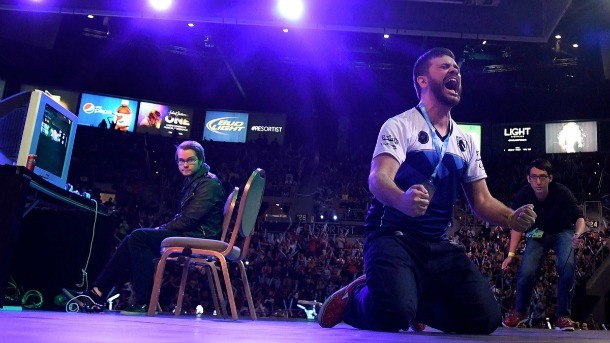
Hungrybox celebrates his win over Armada at EVO 2016, landing him the championship.
“The communities definitely support each other, and respect the other game for the most part,” says Khan. “I doubt Smash 4 or even future Smash iterations will ever replace Melee.”
The Melee fanbase today has been reborn. The renewed interest brought on by the documentary brought with it new players, who each found their own way to play the game thanks to incredibly deep, interpretive gameplay. As new players developed their own playstyle, they shook up the competitive scene,
“Originally, the competitive scene was slow to develop and evolve; tournaments with over 50 entrants were exceedingly rare for the first couple of years, and the metagame barely advanced,” says Khan. “The growth of both the community and the metagame has been practically exponential, with more advancement taking place in the last 5 years than the first 10.”
After more than a decade of highs and lows, the competitive Melee community is stronger than ever. A dedicated playerbase, with a renewed interest from outside sources, has cemented competitive Melee as one of the most popular fighting games in the scene, even after two sequels. Melee’s real strength lies in its dedicated community, who put the game above all else. Many have dedicated their lives and livelihoods to mastering Melee, to finding how deep the gameplay really goes, and how far they can still push it.
“We’re going on 15 years of competitive play,” says Fabiszak. “In those 16 years, we've hacked it, we've studied it, and we've played game after game, and, to me it’s because we can’t break it. That is astounding to me. “
Smashers might still be lugging CRTs to every event, but Melee fans prove the game isn’t living in the past; it’s here to stay.

Get the Game Informer Print Edition!
Explore your favorite games in premium print format, delivered to your door.
- 10 issues per year
- Only $4.80 per issue
- Full digital magazine archive access
- Since 1991









